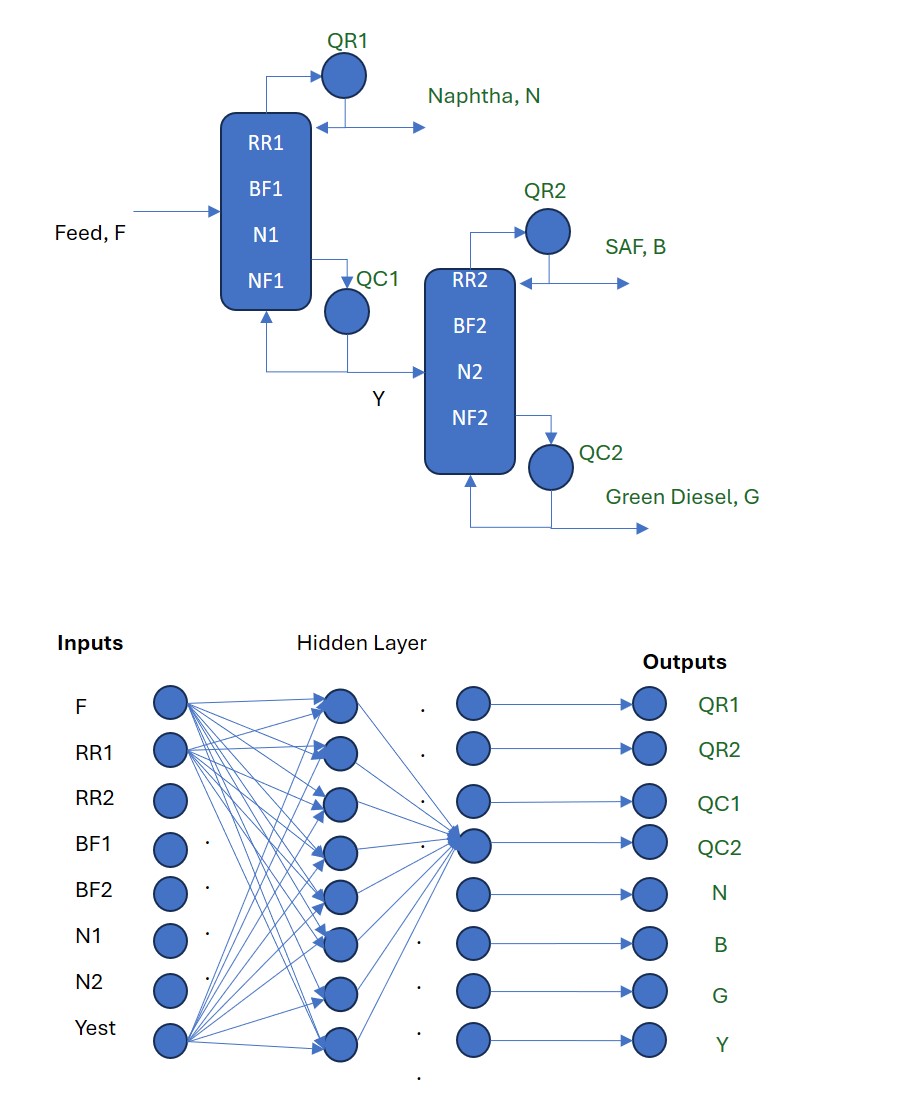MODELING OF A SUSTAINABLE AVIATION FUEL (SAF) DISTILLATION MODULE USING ARTIFICIAL NEURAL NETWORKS
Oscar Gonzalez1, Jorge Aburto2, Elias Martinez-Hernandez2
1 Faculty of Chemistry, National Autonomous University of Mexico
2 Energy Efficiency and Biofuels Division, Mexican Institute of Petroleum
ABSTRACT
An industrial process will be used which consists of obtaining sustainable aviation with green diesel and naphtha as co-products distilled from the hydrotreatment of vegetable oils, which is a process currently investigated at the Mexican Petroleum Institute (IMP). In this work, we aimed to model and simulate the process module in Figure 1 consisting of two distillation columns to separate the products using data generated from process simulations. This allows the implementation of artificial intelligence methods, through artificial neural networks (ANN) to train a surrogate model that can be used to optimize the separation costs including equipment costs (columns, condensers and reboilers), and utility costs for the reboilers and condensers of both columns. We set up a workflow as follows: first the Latin Sampling Hypercube space filling method available in the DiceDesign Package was used to conduct a design of computational experiments which creates a series of data inputs for simulations. The input variables considered were the feed flow rate (F1) to the separation module, the number of stages (N1, N2), feed stage (NF1, NF2), reflux ratio (RR1, RR2) and bottoms-to-feed ratio (BF1, BF2) of the columns. In addition, an estimated flow rate of the intermediate stream between the columns (Yest) was included in the inputs to drive mass balance in the network. The outputs of interest were the heat duties of reboilers (QR1 y QR2), cooling duties of coolers (QC1, QC2) and the mass flow rates of the products (biojet fuel B, green diesel G, and naphtha N) and the intermediate stream (Y). After data analysis, the data was split into test and train sets and input into the MATLAB neural network training toolbox using the Bayesian Regularization method, with one hidden layer and varying the number of hidden neurons to minimize the mean squared error (MSE) of the test set. The final ANN with 8 hidden neurons had the lowest MSE and mean average percentage errors between 0-2% for the flow rates, and 2-5% error for the heat and cooling duties. The ANN was then used to optimize the module of the two distillation columns through economic cost correlations and mass balance constraints using the optimization toolbox in MATLAB. For a fixed feed flow rate of F1=1527.2 kg/h, the optimal values for design variables were N1= 10, N2= 29, NF1=3, NF2=19, RR1= 0.15, RR2=0.16, BF1=0.82, BF2=0.073. For validation of the optimization obtained with the ANN, an optimization in Aspen Plus simulator was carried out to compare the results. Both methods converged to the same values for the decision variables, and the simulation results had a difference <4% for all variables, except for green diesel flow rate which had a 13.4% difference. These results showed promise for further development of a hybrid model considering short-cut calculation methods to improve the predictions of ANN and optimization results.


